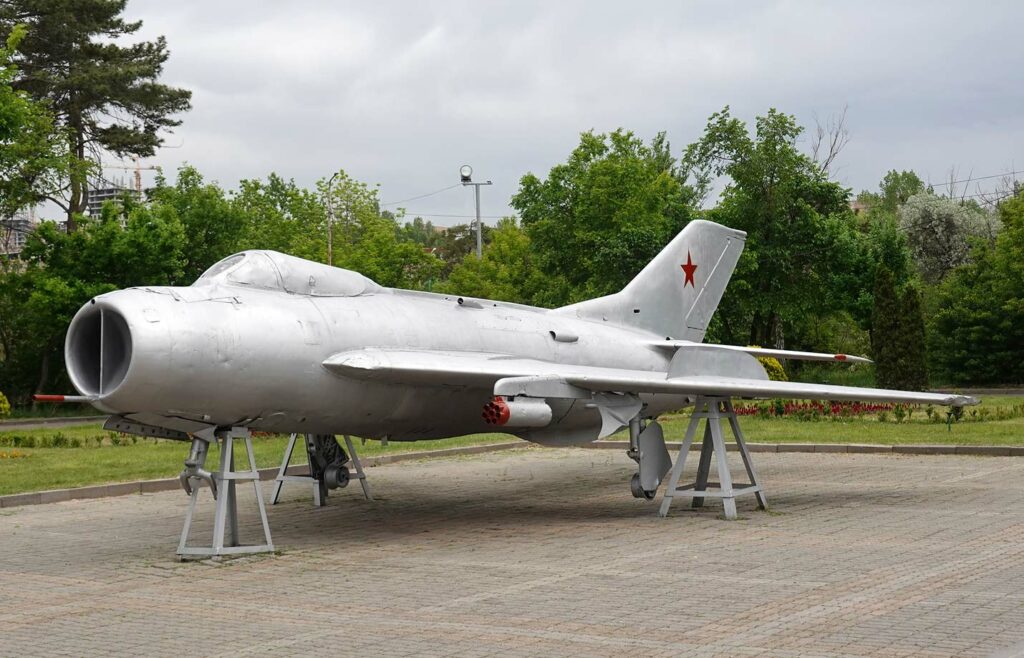The MiG-19 Farmer is a Soviet twin-engine, supersonic jet fighter known for its high speed and powerful armament.
In brief
The Mikoyan-Gurevich MiG-19, known by its NATO reporting name “Farmer,” was the first Soviet production aircraft capable of supersonic speeds in level flight. Introduced in 1955, it was developed to replace the sub-sonic MiG-15 and MiG-17. As a second-generation jet fighter, the MiG-19 was a significant step forward in Soviet aviation technology. It was equipped with twin afterburning turbojet engines and was armed with three 30-mm cannons. Despite some initial design and safety issues, the MiG-19 was a formidable interceptor and ground-attack aircraft. It was extensively used by the Soviet Air Force and exported to numerous countries, continuing to serve in some air forces well into the late 20th century.
The Mikoyan-Gurevich MiG-19 Farmer marked an important transition in Soviet fighter aircraft design, introducing supersonic capabilities to the Soviet Air Force.
History of the Development of the Mikoyan-Gurevich MiG-19 (Farmer)
In the early 1950s, with the advent of jet technology, the Soviet Union sought a new fighter to replace the MiG-15 and MiG-17. The MiG-19 was developed to meet this need, with a requirement for supersonic speed in level flight. The final prototype, designated SM-9, first flew in 1954, achieving Mach 1.19. It entered production on February 17, 1954, as the MiG-19.
The aircraft’s early versions, however, faced several challenges, including mid-air explosions due to poor insulation between the engines and fuel tanks. Subsequent modifications addressed these issues, and the MiG-19S variant introduced an all-flying tailplane and enhanced armament.
The MiG-19 also evolved into an all-weather interceptor, the MiG-19P, and a missile-equipped variant, the MiG-19PM. A high-altitude version, the MiG-19SV, was developed in response to American high-altitude reconnaissance efforts.
Design of the Mikoyan-Gurevich MiG-19 (Farmer)
The MiG-19 was a twin-engine, single-seat fighter with a dramatic 55-degree swept wing design. It was powered by two Tumansky RD-9B afterburning turbojet engines, each producing 7,100 lbs of thrust. The aircraft was armed with three 30-mm NR-30 cannons and had four external hardpoints for missiles or bombs.
The design improvements in the MiG-19S addressed the early model’s instability at supersonic speeds and fuel tank overheating issues. The aircraft featured a rugged airframe capable of high-performance air-to-air combat, interception, ground attack, and close-air support roles.

Performance of the Mikoyan-Gurevich MiG-19 (Farmer)
The MiG-19 had a maximum speed of 955 mph (1,540 kph) at altitude, a service ceiling of 58,725 feet (17,900 meters), and a combat radius of 425 miles (685 kilometers) with drop tanks. The aircraft’s agility and speed made it a formidable adversary in air combat.
The MiG-19’s performance was competitive with contemporary Western fighters such as the U.S. F-100 Super Sabre. However, it was prone to hydraulic failures and in-flight fires, primarily due to manufacturing defects.
Variants of the Mikoyan-Gurevich MiG-19 (Farmer)
Several variants of the MiG-19 were produced:
MiG-19: The initial production version.
MiG-19S (Farmer-C): Improved interceptor with new engines and redesigned tail surfaces.
MiG-19P (Farmer-B): All-weather radar-equipped interceptor.
MiG-19PM (Farmer-D): Missile-armed variant.
MiG-19SV: High-altitude version.
J-6: Chinese license-built version of the MiG-19S/SF.
F-6: Export version of the Chinese J-6.
Other variants included reconnaissance and trainer models.Military Use and Combat of the Mikoyan-Gurevich MiG-19 (Farmer)
The MiG-19 was used by the Soviet Air Force and numerous other countries, including China, Egypt, North Vietnam, and Pakistan. It saw action in various conflicts, such as the Vietnam War, Middle East conflicts, and the Iran-Iraq War. The aircraft was effective in air-to-air combat and ground attack roles, though its operational peak was eventually surpassed by more advanced designs like the MiG-21 and MiG-29.
The Mikoyan-Gurevich MiG-19 Farmer was a significant step in the evolution of Soviet jet fighters, introducing supersonic capability and setting the stage for more advanced aircraft. Despite its initial problems, the MiG-19 proved to be a versatile and effective fighter, serving in various roles and conflicts worldwide. Its legacy is marked by its role as a bridge between early jet fighters and more advanced supersonic aircraft.
Back to the Fighter Jet section.